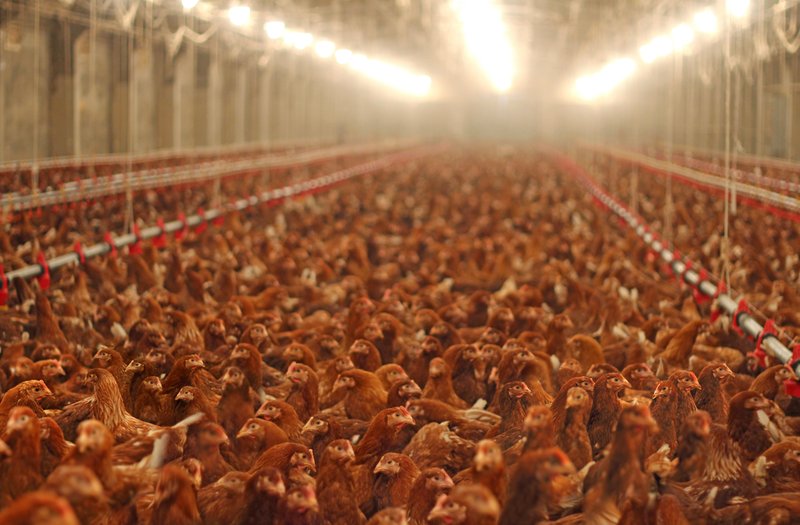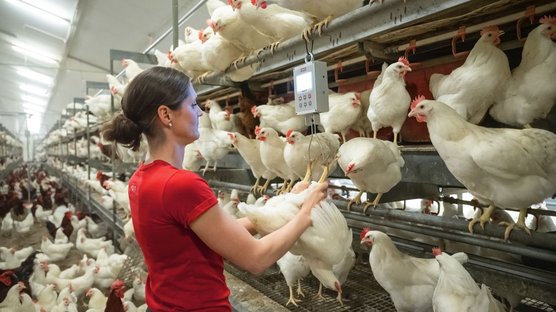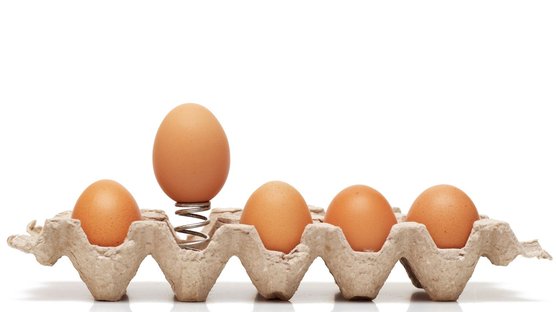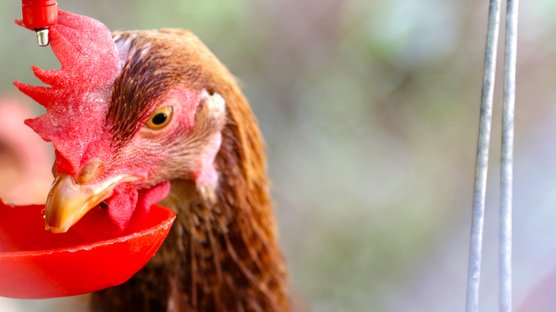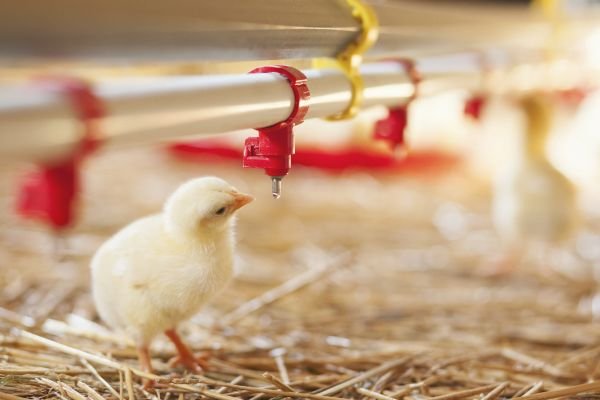
Published on June 14, 2021
Preparing the Long-Life Layer
Well begun is half done, an old saying which also is true for egg producers as a good quality pullet helps to reach the targets set for the productive life of laying hens. The pullet rearer has about 17 weeks to develop this tiny day-old chick into a ready to lay laying hen. The productive life of a laying hen has increased drastically over the past decades and because of balanced genetic selection this is still increasing 1 week with every new flock that enters the poultry house. Keeping laying hens all the way up to 100 weeks of age without molting is no longer exceptional, it is not the global standard yet, but more and more proven results are clearly there. A good quality pullet is essential to get the best out of your flock, in this technical paper we aim to describe some of the main objectives and targets to be reached during the rearing period.
The rearing period is of major importance for the performance of the flock later in life. The productivity of a flock depends to a large extent on the successful attainment of bodyweight targets from an early age. Also egg size profiles during lay and the feather cover during the productive period are influenced by the development of the pullets. During first weeks in rearing, management should focus on rapid and steady chick growth while the second half of the rearing period is the right time to work on developing feed intake capacity. In addition to this, achieving a proper uniformity within a flock is also essential to obtain good laying performances.
The different chick development phases in the rearing period
The main objectives during the brooding period are:
- Rapid growth to reach body weight target at 5 weeks of age
- Good uniformity from the beginning
- Maintaining excellent livability
From day old to transfer, the chicks will grow slowly, and organ development occurs at various ages. A lack of growth during any of the growth stages can have a detrimental impact on the 17-week-old pullet quality. Any delay in growth at 4-5 weeks of age, will be reflected in a reduction in bodyweight at 16 weeks and then in performance, particularly in mean egg weight in temperate climates. Keep in mind that two pullets with the same bodyweight haven’t necessarily developed the same body composition, it all depends on the growth curve. Good growth curves result in good pullet development. The growth and developments of laying hens is split in the following stages (visualized in the graph at the end).
- The first 3 weeks are devoted to a rapid development of the organs of the digestive tract and the immune system.
- From week 3 to week 6, skeleton and muscles are rapidly growing. Bodyweight at 5/6 weeks is the most important determinant of pullet quality. Any delay in growth at this stage is harmful to the birds, as it will have a detrimental impact on pullet quality and body composition, which will in return impact negatively the birds’ performance.
- From week 7 to week 15 growth rate is starting to slow down. By 12 weeks skeleton is almost completely developed and the pullets are practically fully grown in terms of size.
- The final stage is characterized by ovary development and rapid growth of the reproductive tract. Sexual hormonal regulation takes place around 18 weeks and leads to sexual maturity around this age. Medullary bone also develops during this period, about 2 weeks before first egg is laid.
At all stages of chick development, flock uniformity needs to be reviewed. The objective is to have a very high uniformity to facilitate flock management and proper light stimulation. It is well known that low flock uniformity leads to poor egg laying performance: slow onset of lay, poor and late peak of production and increased number of small eggs. The number of feeders and drinkers, feed distribution, the presentation of the feed and the farmers’ management are strong contributors to ensure uniformity. Heterogeneity at early age has a negative impact on uniformity at the end of the rearing period, before birds are transferred.
Building the potential during the growing period
After a good start during the brooding period, the main goal of the growing period is to ensure the full development of the birds so that they reach their highest potential for producing eggs later in life. The objectives during the growing period are:
- to establish a good feeding behavior pattern
- to develop the digestive tract (crop and gizzard)
- to obtain a good uniformity of at least 80%
- to achieve the recommended body weight at sexual maturity
These objectives can be achieved by:
- correct stocking density, proper feeding and drinking equipment and housing conditions
- a lighting program adapted to the rearing conditions
- a good standard of beak treatment (when local legislation allows the application of beak treatment)
- correct disease prevention: good biosecurity and adapted vaccination program
- good management of the feeding program and feeding techniques
We will highlight feeding techniques and the monitoring of chick development further in this article.
Bodyweight development graph
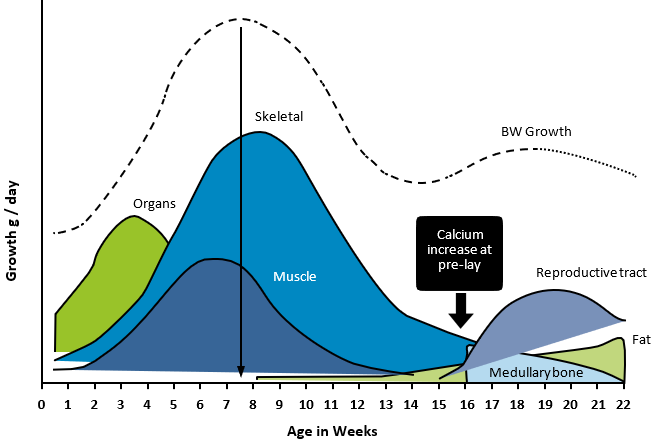
Feeding Technique
Feed management in rearing has an impact on feed consumption later in production. The idea is to develop the digestive tract during the rearing phase to prepare the birds to eat enough during the laying phase, especially immediately after transfer, when feed intake should increase sharply in just a few weeks. The crop is the bird’s feed storage organ. Rapid feed consumption during rearing leads to crop development. Therefore, feed consumption during the rearing period needs to be fast enough and eating speed will depend mainly on feeding times and feed texture. Birds naturally eat earlier in the morning, when their digestive tract is empty, and in the evening, to satisfy their energy needs throughout the night. It is important to take advantage of this natural behavior and get empty feeders in the middle of the day. The feeding techniques used between 5 and 16 weeks are designed to avoid the build-up of fine particles in the feeders and to encourage crop development through rapid feed intake. By nature, chickens are grain eaters with a strong preference for coarse particles. Fine particles are more difficult for birds to eat; therefore, they spend more energy for the same quantity consumed. The accumulation of fine particles in the feeding system leads to under-consumption. To ensure the birds can get all the necessary nutrients of the diet, it is essential that the feeders are emptied every day from week 5 of age onwards. Even at earlier age it is recommended that chicks get used to empty the feeders at least once per week. This “empty feeder” rule applies equally to pullets and layers. To encourage rapid consumption, we recommend that the complete daily ration should be given about 2 to 3 hours before “lights off”. At “lights on”, because the digestive system is empty, the birds will eat finer particles. If the feeding system does not allow the entire daily ration to be given in one distribution, distribute 60% of the daily ration in the early afternoon and the 40% in the morning at “lights on”. This feeding routine can be started between 4 and 8 weeks according to the feeding equipment in use. The length of time, during which the feeders are empty, should be gradually increased, so that by around 10- 12 weeks of age the feeders are empty for a minimum of 2 to 3 hours per day.
Pullet feed presented in coarse particles helps gizzard development. We recommend using a feeding system which distributes feed rapidly throughout the house and enables the birds to finish all the feed distributed each day. This encourages the birds’ intake capacity and avoids fine particle accumulation. Feed troughs with rapid chains are the best option, with the easiest feed intake control. If pan or tube feeders are used, they should be adapted specifically for this technique. Developing the gastrointestinal tract and feed intake capacity, by both developing the gizzard for optimal digestion and by training the pullets to eat, are key to help them to rapidly increase their feed consumption in the first few weeks of lay and therefore a much smoother transfer towards the laying phase.
Monitoring development
Weekly measurement of growth is an absolute must to check the actual development of the flock. Early detection of abnormal weight gain is of extreme importance to determine what corrective actions must be taken. Late attempts to correct low bodyweight are not efficient at improving body composition and frame size. In addition to this, monitoring of body weight is essential to calculate the appropriate quantity of feed to be issued, as requirements vary according to the energy level of the diet as well as the house temperature and the health status of the flock. Besides the average body weight of the flock it is also important to calculate its uniformity. The objective is to have a high uniformity to ensure an even response across the flock to management techniques, treatments and especially to light stimulation. If all the birds within a flock have a uniform development, they will react as one and they will be easier to manage.
Method of weighing control:
- Weighing time should be fixed, preferably in the afternoon.
- It is recommended carrying out individual weighing and using histogram type weighing sheets (see the chart on the next page) which shows immediately the weight distribution within the population.
- A sample of a minimum of 100 birds should be taken to obtain a good estimate of mean bodyweight and uniformity. However, if the flock is divided into separate pens, it is necessary to take a sample of 60 birds from each pen and then to calculate the overall mean. When rearing in cages, weigh all the birds from 5 or 6 cages, chosen at random, in different parts of the poultry house (upper and lower tiers, start and end of feeding lines), to make up a significant sample. All the birds from these same cages should be weighed every week.
The most important factor in judging the quality of a flock is its uniformity. A batch is uniform when at least 80% of the weights lie within a range of ± 10% of the mean. Using modern weighing devices, it is also possible to obtain the coefficient of variation (CV), which is the ratio of standard deviation to the mean of the population expressed in %. A CV below 8% is good
Bodyweight recording chart
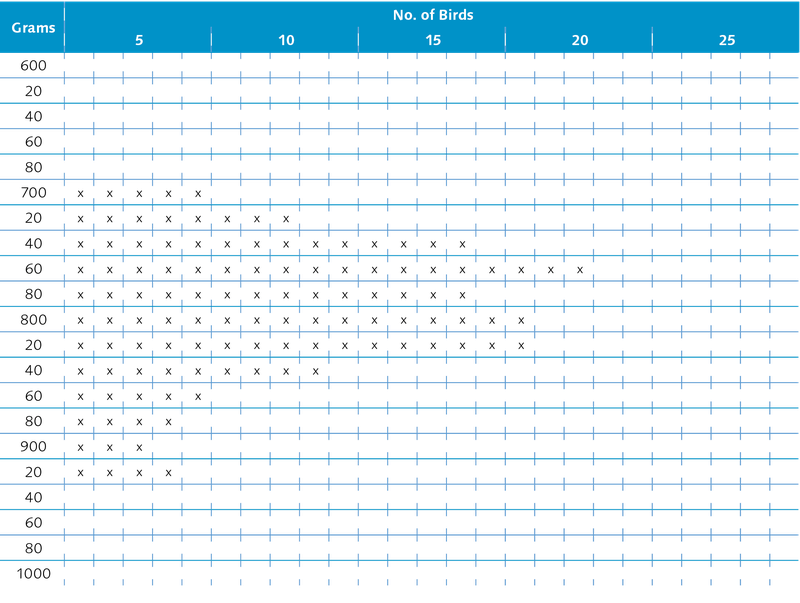
If uniformity/CV % is outside the target range, it is necessary to identify the causes and to check:
- Stocking density
- Available feeder space
- Distribution and height of feeders and drinkers
- Speed of the feed chain
- Feeding technique: accumulation of fine particles
- Feed texture: if inadequate it leads to feed selection
- Feed composition and quality
- Quality of beak treatment
- Vaccination status and possible post-vaccinal reactions
- Health condition of the flock: disease and parasitism presence
Depending on the identified causes and the conclusions that can be drawn from the analyses, corrective actions should be implemented, and management adapted to improve the uniformity of the flock.
To conclude
The monitoring of the development of your flock during the rearing period is key. Objective data tells you more than observing the flock on a daily base alone. It is the combination of data and a careful inspection to catch the signs that your flock are giving to you. Ask yourself the question if the chicks are growing well and they develop into quality pullets with the desired bodyweights? Is the flock uniformity according to your standards, how do they respond to vaccinations? By careful monitoring the development of the flock and trying to look for answers you can re-act better and steer better to develop the chicks into lifelong layers.
